Geology Reference
In-Depth Information
N
strike
ss
W
rake
ds
slip
dip
Fault
Terminology
L
Fig. 11.1
Definition sketch for the elements of a dipping fault that must be prescribed in models of landscape
evolution with specific faults.
The spatial orientation of the fault is dictated by the strike and dip of the fault, and the size of the fault is dictated by
the length
L
(horizontal) and height (also sometimes called width)
W
(down-dip) of the fault. The slip on the fault
may be prescribed by specifying either the dip-slip (ds) and strike-slip (ss) components, or the total slip and the rake
of the slip event. Parallel lines scribed on the fault surface are meant to indicate slickenlines associated with slip in
one event.
specifying the dip-slip and the strike-slip compo-
nents of displacement. In general, the slip on the
fault is assumed to be either uniform or variable
from point to point on the fault plane.
Given these specifications of the fault, the
boundary conditions on the fault, and the edges
of the volume, one then calculates the expected
material dislocations (and, if desired, the strains
and stresses, e.g., Fig. 4.6) at any other point
within the material. Because most measure-
ments of displacement are made on the surface
of the Earth, it is usually the deformation field
(horizontal and vertical) at the surface of
the Earth that is solved for and reported by the
code. Given that elastic problems are linear, one
may superpose the solutions for any number of
discrete dislocations (faults) within the material.
For example, fault bends and step-overs are
dealt with by breaking the fault into several dis-
crete segments, each with its own deformation
pattern. One may also calculate the displacement
field associated with a complex pattern of slip
on a single planar fault by breaking up the fault
into a series of smaller planes. The simplest
pattern of slip is, of course, uniform. More com-
plex patterns can be constructed that vary either
smoothly, e.g., in an elliptical pattern (Crider
and Pollard, 1998; Willemse
et al
., 1996), or more
irregularly. The deformation field associated
with a single fault and driven by an imposed
displacement of the edges of the volume are
expected to differ for both normal and reverse
faults and for faults that do and that do not cut
the surface (Fig. 11.2).
Models differ in how they deal with the
material at depths greater than those expected
to behave in an elastic manner. The simplest
assume that the entire Earth behaves as an
elastic half-space, but more realistic models
employ a region at moderate depths that relaxes
viscously (e.g., King
et al
., 1988).
One of the more widely available boundary
element codes (3DDEF; Gomberg, 1993;
Gomberg and Ellis, 1993, 1994) is now being
used to assess the cross-talk between faults in
complicated real-world settings. Given the abil-
ity to calculate the changes in the state of stress
within the material imposed by the slip on one
fault, one may calculate how one rupture loads
up other nearby faults, placing them either
closer to or further from failure, as we have
discussed elsewhere in this topic (e.g., Fig. 4.6) -
and see also Stein and Ekstrom (1992), Simpson
et al
. (1994), Simpson and Reasenberg (1994),
Li
et al
. (1998), Harris and Day (1993), and
Harris
et al
. (1995).
Those models that operate at the orogen
scale cannot possibly take into account all the























































